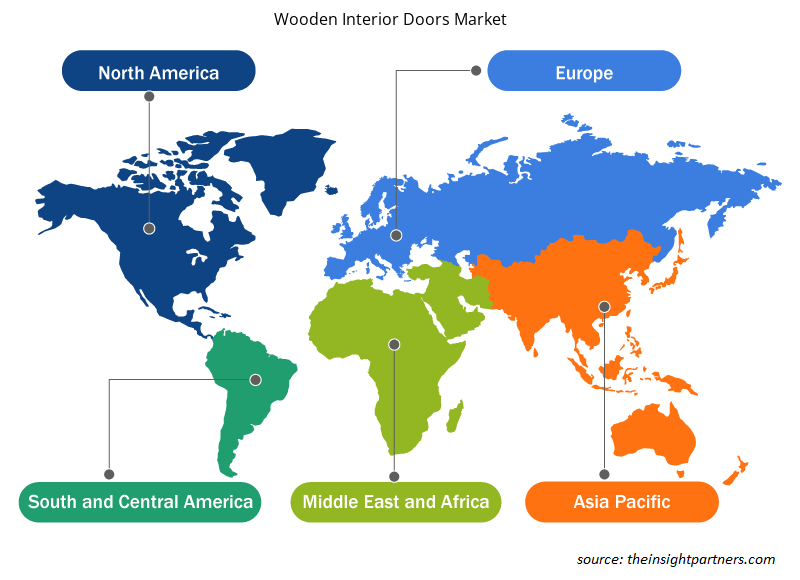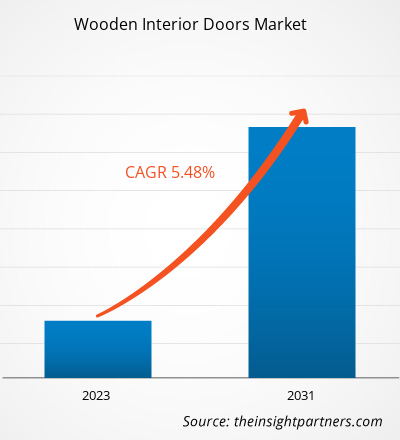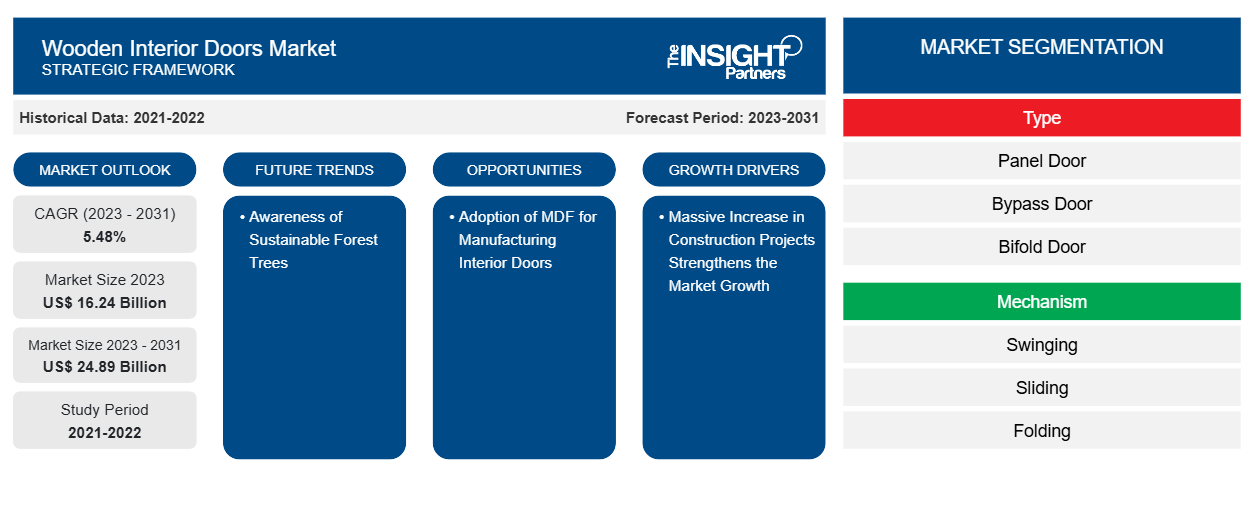木质室内门市场规模预计将从 2023 年的 162.4 亿美元增至 2031 年的 248.9 亿美元。预计 2023-2031 年市场复合年增长率为 5.48%。根据《全球建筑 2030》报告,预计到 2030 年,全球建筑产出量将增长 85%,达到 15.5 万亿美元。预计美国、中国和印度将引领这一趋势,占全球增长的一半以上。此外,对旧建筑和结构的改造投资以及对绿色未来的日益倾向正在扩大绿色建筑的范围,从而进一步促进建筑业的发展。
木质室内门市场分析
在城市化日益发展的时代,建筑业正以惊人的速度蓬勃发展。随着建筑项目的增加,对相关部件(包括室内门等家具产品)的需求也在蓬勃发展。因此,为了跟上城市化发展的步伐,同时不对环境造成任何有害影响,正在实施可持续林业。可持续林业的重点是通过实施造林和再造林以及使用影响较小的伐木技术来保护天然林。
木质室内门市场概况
据估计,住房需求将继续增长,因此,找到合适的解决方案是满足城市人口需求的必要条件。据预测,到 2030 年,将有 30 亿人(占世界人口的近 40%)需要新的住房设施,这意味着需要大约 3 亿套新住宅。因此,上述不断增长的住房需求,加上对安全环境的需求,正在推动可持续林业的概念。这将对木质室内门市场的增长产生积极影响。
定制此报告以满足您的需求
您可以免费定制任何报告,包括本报告的部分内容、国家级分析、Excel 数据包,以及为初创企业和大学提供优惠和折扣
- 获取此报告的关键市场趋势。这个免费样品将包括数据分析,从市场趋势到估计和预测。
木质室内门市场驱动因素和机遇
建筑项目大量增加推动市场增长
随着城市人口的增加,城市地区对高层建筑的需求也大幅增加。根据高层建筑和城市人居委员会 (CTBUH) 的数据,过去二十年,美国建造了 1,480 座高度超过 200 米的摩天大楼。这一数字还包括近几年建造的 40 座住宅摩天大楼。由于城市化进程加快,住宅、商业和多个行业的建筑工程激增,推动了室内门的需求增长。政府机构更加注重加强建筑和基础设施建设,这进一步推动了对室内门的需求。
采用中密度纤维板制造室内门
MDF 是一种工程木制品,通常由再生木纤维制成。MDF 因其耐用性和价格实惠而成为最常用的室内门材料。此外,MDF 室内门比胶合板和刨花板更致密,这是吸引住宅和商业的另一个因素。除了上述特点外,MDF 的边缘非常光滑,不需要层压板,这使得 MDF 不同于刨花板和其他木质材料。因此,MDF 的受欢迎程度呈上升趋势,预计将为木质室内门制造商提供丰厚的商机。
木质室内门市场报告细分分析
有助于得出木质室内门市场分析的关键部分是类型、机制和最终用户。
- 根据方法,市场分为面板门、旁路门、双折门、口袋门等。面板门部分在 2023 年占据了较大的市场份额。
- 根据机制,全球木质室内门市场分为以下几种类型:平开门、滑动门、折叠门和其他类型。2023 年,平开门占据了较大的市场份额。
- 根据最终用户,全球市场分为住宅和非住宅。住宅市场在 2023 年占据了更大的市场份额。
木质室内门市场份额按地区分析
木质室内门市场报告的范围包括北美(美国、加拿大和墨西哥)、欧洲(西班牙、英国、德国、法国、意大利和欧洲其他地区)、亚太地区(韩国、中国、印度、日本、澳大利亚和亚太地区其他地区)、中东和非洲(南非、沙特阿拉伯、阿联酋和中东和非洲其他地区)以及南美洲和中美洲(巴西、阿根廷和南美洲和中美洲其他地区)。就收入而言,亚太地区在 2023 年占据了木质室内门市场份额的主导地位。欧洲是全球木质室内门市场的第二大贡献者,其次是北美。在全球市场格局中,中国是 2022 年最大的中密度纤维板消费国之一,占总市场份额的 50% 以上。此外,中国的中密度纤维板消费量超过了美国。白俄罗斯、土耳其和波兰是其他以人均中密度纤维板消费量最高而闻名的著名市场。这些国家的如此高的消费趋势预计将推动中密度纤维板在制造家居用品(包括室内门)领域的应用。
木质室内门市场区域洞察
Insight Partners 的分析师已详尽解释了预测期内影响木质内门市场的区域趋势和因素。本节还讨论了北美、欧洲、亚太地区、中东和非洲以及南美和中美洲的木质内门市场细分和地理位置。

- 获取木质室内门市场的区域特定数据
木质室内门市场报告范围
| 报告属性 | 细节 |
|---|---|
| 2023 年的市场规模 | 162.4亿美元 |
| 2031 年市场规模 | 248.9亿美元 |
| 全球复合年增长率(2023 - 2031) | 5.48% |
| 史料 | 2021-2022 |
| 预测期 | 2023-2031 |
| 涵盖的领域 | 按类型
|
| 覆盖地区和国家 | 北美
|
| 市场领导者和主要公司简介 |
|
木质室内门市场参与者密度:了解其对业务动态的影响
木质室内门市场正在快速增长,这得益于最终用户需求的不断增长,这些需求源于消费者偏好的不断变化、技术进步以及对产品优势的认识不断提高等因素。随着需求的增加,企业正在扩大其产品范围,进行创新以满足消费者的需求,并利用新兴趋势,从而进一步推动市场增长。
市场参与者密度是指在特定市场或行业内运营的企业或公司的分布情况。它表明在给定市场空间中,相对于其规模或总市场价值,有多少竞争对手(市场参与者)存在。
在木质内门市场运营的主要公司有:
- 概念SGA公司
- 辛普森门公司
- 杰德温控股公司
- 马文有限公司
- 美森耐国际公司
- 木纹公司
免责声明:上面列出的公司没有按照任何特定顺序排列。

- 了解木质室内门市场主要参与者概况
木质室内门市场新闻和最新发展
木质室内门市场通过收集一手和二手研究后的定性和定量数据进行评估,其中包括重要的公司出版物、协会数据和数据库。以下是木质室内门市场的发展和战略列表:
- 2022 年 2 月,Simpson Redi-Prime 扩大了其产品线,包括用于家中独特空间的 Clipped Corner Doors,Simpson Redi-Prime 是制作精美的彩绘室内门的最知名品牌之一。随着许多人继续进行装修以适应不断变化的家庭功能,Redi-Prime Clipped Corner Door 的顶角以一定角度预先切割以进行定制。结果是针对任何无法容纳标准方顶室内门的应用的专用设计解决方案。(来源:Simpson Door Company,新闻稿/公司网站/时事通讯)
木质室内门市场报告覆盖范围和交付成果
“木质内门市场规模和预测(2021-2031)”报告对以下领域进行了详细的市场分析:
- 范围内所有主要细分市场的全球、区域和国家层面的市场规模和预测
- 市场动态,如驱动因素、限制因素和关键机遇
- 未来主要趋势
- 详细的波特五力分析
- 全球和区域市场分析涵盖关键市场趋势、主要参与者、法规和最新市场发展
- 行业格局和竞争分析,涵盖市场集中度、热点图分析、知名参与者和最新发展
- 带有 SWOT 分析的详细公司简介
- 历史分析(2 年)、基准年、预测(7 年)及复合年增长率
- PEST和SWOT分析
- 市场规模、价值/数量 - 全球、区域、国家
- 行业和竞争格局
- Excel 数据集
近期报告
相关报告
客户评价
购买理由
- 明智的决策
- 了解市场动态
- 竞争分析
- 客户洞察
- 市场预测
- 风险规避
- 战略规划
- 投资论证
- 识别新兴市场
- 优化营销策略
- 提升运营效率
- 顺应监管趋势























 获取免费样品 - 木质室内门市场
获取免费样品 - 木质室内门市场